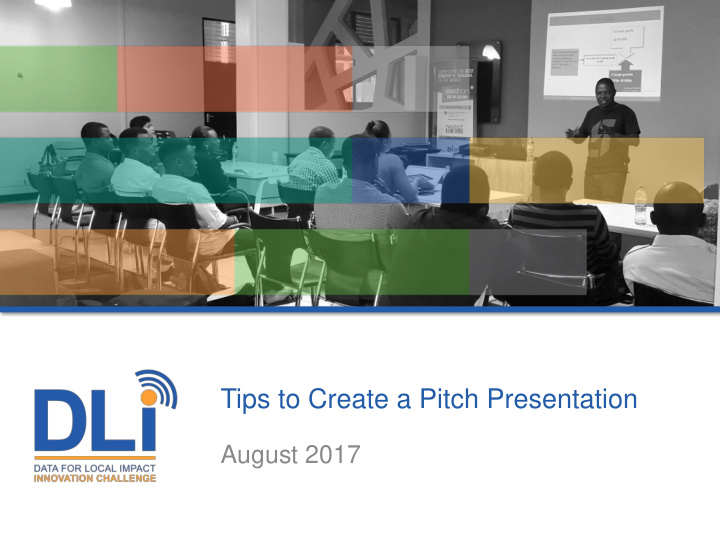



Tips to Create a Pitch Presentation August 2017
Tip # 1: Think about your presentation last • Think about your content and story based on what you included in your proposal — main message, problem, solution, impact — and then start thinking about your slides. • The presentation needs to stand on its own. The slides should enhance the listener’s visual experience.
Tip # 2: Anticipate the judges’ questions and address them in your presentation • There will be 5 minutes after each pitch for Q&A • This is a very short time. Do not waste it by making the judges inquire about basic information that should have been addressed in the pitch itself, such as the problem, solution, impact, viability and innovation. • Try to weave this information into your presentation
Tip # 3: Less is more • A single word or line of text can have more impact than a paragraph • Busy slides distract listeners from processing what a speaker is saying • In general, choose images over text • Slides should be easy to understand • Keep graphs visually clear • No slide should support more than one point • Cut any slide that does not have a clear purpose • Do not use font smaller than 20 points
Tip # 4: Create a consistent look and feel • Each slide should feel like part of the same story • Use the same or related typography, colors and imagery across all your slides
Tip # 5: Use photos that enhance meaning Simple, effective photos in presentations help resonate in your audience’s mind without pulling their attention from your spoken words. Look for photos that: (1) Speak strongly to the concept you’re talking about (2) Aren’t compositionally complex. Your photo could be a metaphor or something more literal, but it should be clear why the audience is looking at it, and why it’s paired with what you’re saying. (3) You can find high-quality vector files, images and illustrations at Pixabay that are free to use https://pixabay.com (4) Do not use PowerPoint’s ClipArt
Example: Good imagery can help make a point SURVIVING A MEDIA INTERVIEW The picture chosen for this slide complements the title and showcases how a media interview can be overwhelming and scary
Tip # 6: Use Infographics (Before) To break up text, use numbers or illustrate statistics to help show the point visually. Instead of saying: 50% of people in the world are women. >> See next slide
Visually show what it means to have 50% of the world be woman by highlighting half of the globe and include an image (After) 50% of people in the world are women
Designing Infographics • Use simple shapes or charts solidly filled with colors from your palette • The presentation helps tell your story and serves as a reminder on what you are going to talk about • If you feel stuck, consider using one of the free online infographic creators :http://www.creativebloq.com/infographic/tools-2131971 Thing 1 Thing 2 Object 1
Tip # 7: Think about unique ways information can be laid out (Before)
Switching from vertical to horizontal can make a difference. Iconography also helps break some of the text. (After)
Tip # 8: Use Data to Provide Context • How big is the problem/solution that you are trying to solve? • Where is it located? • Why is your solution unique (compared to other initiatives)? • Has this been done in the past? EXAMPLE: Instead of: We are helping people in Kigoma who need access to a road. Say: For the first time in history, 1 million people in Kigoma, the Westernmost city of Tanzania, will have access to a road that will connect them with the rest of the country so they can access better healthcare, markets and schools.
Tip # 9: Tell a Story • Start with a story about the solution, the team or beneficiaries behind the idea. • Show how this individual story is bigger, affects a lot more people, or can be scaled up • Stories help make information become memorable and therefore easier to share and repeat. • Think of soundbites.
Tip # 10: Practice makes perfect! • Recommended Resources: – Books • Resonate by Nancy Duarte • Slide:ology by Nancy Duarte (http://www.duarte.com/book/slideology/) – Presentations • Benjamin Zander’s TED Talk about classical music (https://www.youtube.com/watch?v=hKOHHVnX6Qs)
dliinnovationchallenge.com @DLIInnovation 16
Recommend
More recommend